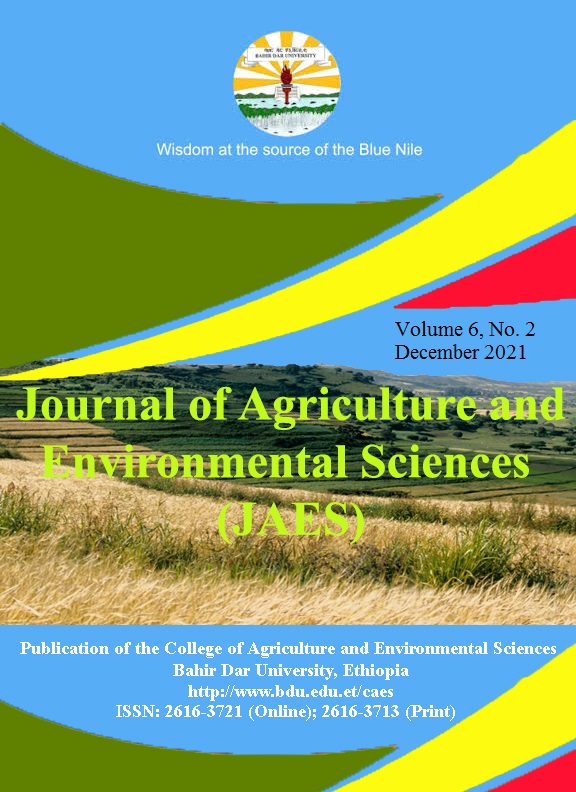Yield and Nutritional Quality of Oat (Avena sativa) Genotypes under Vertisols Conditions in the Central Highlands of Ethiopia
Abstract
Shortage of feed is a critical problem for livestock production in Ethiopia. However, the selection of oat
genotypes that perform better under vertisol conditions is very important to mitigate the feed shortage problem in
the central highlands of Ethiopia. So, the study was designed to evaluate the agro-morphological and nutritional
performance of fifteen oat genotypes under vertisol conditions during the main cropping seasons of 2015 and 2016
at Kuyu and Ginchi sub-stations of Holetta Agricultural Research Center. Randomized complete block design
replicated three times was used for evaluating the genotypes. The genotypes were sown with the recommended
seeding rate of 100 kg ha-1 using an inter-row spacing of 20 cm. Diammonium phosphate (DAP) fertilizer at the rate
of 100 kg ha-1 was uniformly applied at sowing for all genotypes at both locations and years. Data were collected on
plant height, dry matter yield, leaf to stem ratio, straw yield, seed yield, thousand seed weight, harvest index, and
nutritive values. All measured data were subjected to analysis of variance using procedures of SAS general linear
model. The genotypes responded differently (P<0.001) for plant height, leaf to stem ratio, straw yield, seed yield,
thousand seed weight, and harvest index. All measured agro-morphological traits of oat genotypes were
significantly influenced by genotype by location by year interaction. In both cropping seasons, the genotypes
produced relatively better dry matter yield at Kuyu than Ginchi indicating the performance of genotypes was highly
hampered by heavy vertisol characteristics of Ginchi location. In the over years and locations combined analysis,
genotypes 1600, 1740, 2596, 79983, 1493, and 1742 produced more than 15 t ha-1 dry matter yield at the soft dough
stage. Oat genotypes that had relatively higher plant height and better dry matter yield showed higher straw yield
when compared with small plant height and lower dry matter-producing genotypes. The mean seed yield
performance of oat genotypes in the combined analysis was 2250 kg ha-1 and the highest seed yield was recorded for
genotype 2806 followed by 79983, 2291, 8251, and 1742. Moreover, the chemical and in-vitro dry matter
digestibility analysis of oat genotypes was done and genotype 1486 produced the highest crude protein and in-vitro
dry matter digestibility contents while the lowest was recorded from genotype SAIA. The highest crude protein yield
was recorded for oat genotype 2291 followed by 2596, 2806, 1506, and 1742 and oat genotypes that produced the
highest crude protein yield also gave the highest digestible yield. Generally, better dry matter yield, crude protein
yield, digestible yield, and seed yield performances were recorded from genotypes 2291, 2596, 2806, 1506, 1742,
8251, and 79983. Therefore, these oat genotypes were recommended for vertisol conditions of the study areas and
similar agro-ecologies.
Copyright (c) 2021 Journal of Agriculture and Environmental Sciences

This work is licensed under a Creative Commons Attribution-NonCommercial 4.0 International License.
Authors who publish with this journal agree to the following terms:
- Authors retain copyright and grant the journal right of first publication with the work simultaneously licensed under a Creative Commons Attribution License that allows others to share the work with an acknowledgement of the work's authorship and initial publication in this journal.
- Authors are able to enter into separate, additional contractual arrangements for the non-exclusive distribution of the journal's published version of the work (e.g., post it to an institutional repository or publish it in a book), with an acknowledgement of its initial publication in this journal.
Authors are permitted and encouraged to post their work online (e.g., in institutional repositories or on their website) prior to and during the submission process, as it can lead to productive exchanges, as well as earlier and greater citation of published work (See The Effect of Open Access).


